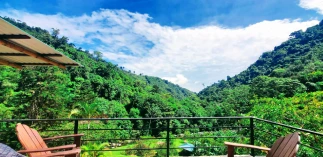High up in the Costa Rican mountains, amidst the verdant tapestry of the cloud forest, flits a tiny acrobat – the Palm Warbler. Don’t be fooled by its unassuming name, this little songbird is a captivating bundle of energy, easily identified by its one truly unique habit: the constant bobbing of its tail.
A Bird of Two Worlds
The Palm Warbler is a fascinating example of a migratory species. Come breeding season, these birds transform the boreal forests of Canada and the northeastern United States into their summer homes. But as winter approaches, they embark on a southward journey, gracing Costa Rica with their presence from September to April.
Here at our mountain retreat, nestled amidst the lush embrace of the cloud forest, you have a fantastic chance of encountering these delightful visitors.
Spotting the Tail-Teller
The Palm Warbler is a small bird, about the size of a sparrow, with a wingspan of just over 9 inches. Their plumage is a beautiful blend of practicality and subtle charm. Their upper body is a soft brownish-olive, perfectly camouflaged against the mossy branches and emerald leaves. But look a little closer, and you’ll see a flash of sunshine – their underparts boast a wash of yellow, particularly vibrant in the eastern subspecies that graces Costa Rica.
The most distinctive feature, however, is undeniably their tail. Unlike most warblers who flit and dart, the Palm Warbler prefers to hop and forage on the ground, its tail constantly bobbing up and down. This quirky habit is a dead giveaway, making identification a breeze for even novice birders.
A Song Unsung, But Not Unheard
While the Palm Warbler might not be the most visually flamboyant bird, it makes up for it with a delightful song. Their melody is a series of short, high-pitched notes, often described as a thin, buzzy trill. You might hear it as they perch on a low branch, surveying their territory with a bright, inquisitive eye.
A Ground-Dwelling Delight
Unlike most warblers who flit from branch to branch in the canopy, the Palm Warbler spends a significant amount of time on the forest floor. Here, they become adept insect hunters, hopping amongst the leaf litter and fallen logs, their tails wagging merrily as they glean spiders, beetles, and other invertebrates from the undergrowth.
A Testament to Resilience
The Palm Warbler is a success story in the avian world. Classified as “Least Concern” by the IUCN, their populations are healthy and even increasing. This is a testament to the vital role they play in the ecosystem, keeping insect populations in check and ensuring the delicate balance of the forest thrives.
So, as you explore the mystical trails of our mountain retreat, keep your eyes peeled for the little bird with the ever-wagging tail. The Palm Warbler, a tireless traveler and a ground-dwelling gourmand, might just become your favorite feathered friend in the Costa Rican cloud forest.
For more information, please view our comprehensive guide about the birds of Costa Rica







